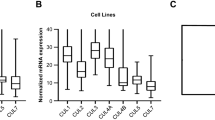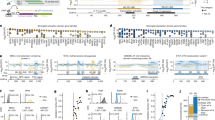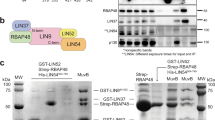Abstract
Extensive mutational/functional analysis of the transcription-repression domain encoded in the N-terminal 80 amino acids of the adenovirus E1A 243R oncoprotein suggests a model for the molecular mechanism of E1A repression: E1A accesses transcriptional co-activators such as p300 on specific promoters and then interacts with TBP to disrupt the TBP–TATA complex. In support of this model, as reported here, a basal core promoter activated by tethering p300 is repressible by E1A at the promoter level as shown by chromatin immunoprecipitation (ChIP) analysis. Sequestration of p300 by E1A does not play a significant role, as indicated by dose-response measurements. Furthermore, when the core promoter is transcriptionally activated by tethering activation domains of several transcription factors that can recruit p300 (p65, MyoD, cMyb and TFE3), transcription is repressible by E1A. However, when the core promoter is activated by factors not known to recruit p300 (USF1 and USF2), transcription is resistant to E1A repression. Finally, tethering p300 to the non-repressible adenovirus major late promoter (MLP) renders it repressible by E1A. ChIP analysis shows that E1A occupies the repressed MLP. These findings provide support for the hypothesis that p300 can serve as a scaffold for the E1A repression domain to access specific cellular gene promoters involved in growth regulation.
This is a preview of subscription content, access via your institution
Access options
Subscribe to this journal
Receive 50 print issues and online access
$259.00 per year
only $5.18 per issue
Buy this article
- Purchase on Springer Link
- Instant access to full article PDF
Prices may be subject to local taxes which are calculated during checkout






Similar content being viewed by others
References
Berk AJ . (2005). Recent lessons in gene expression, cell cycle control, and cell biology from adenovirus. Oncogene 24: 7673–7685.
Boyd J, Loewenstein PM, Tang Q, Yu L, Green M . (2002). The adenovirus 2 E1A N-terminal domain sequence requirements for repression of transcription in vitro and in vivo correlate with those required for E1A interference with TBP/TATA complex formation. J Virol 76: 1461–1474.
Burgers WA, Blanchon L, Pradhan S, De Launoit Y, Kouzarides T, Fuks F . (2007). Viral oncoproteins target the DNA methyltransferases. Oncogene 26: 1650–1655.
Carthew RW, Chodosh LA, Sharp P . (1985). An RNA polymerase II transcription factor binds to an upstream element in the adenovirus major late promoter. Cell 43: 439–448.
Chan HM, La Thangue NB . (2001). p300/CBP proteins: HATs for transcriptional bridges and scaffolds. J Cell Sci 114: 2363–2373.
Chinnadurai G (ed). (2006). CtBP Family Proteins: Unique Transcriptional Regulators in the Nucleus with Diverse Cytosolic Functions. Springer-Eurekah Bioscience, pp 1–17.
Dorris DR, Struhl K . (2000). Artificial recruitment of TFIID, but not RNA polymerase II holoenzyme, activates transcription in mammalian cells. Mol Cell Biol 12: 4350–4358.
Eckner R, Ewen ME, Newsome D, Gerdes M, DeCaprio J, Lawrence JB et al. (1994). Molecular cloning and functional analysis of the adenovirus E1A-associated 300-kD protein (p300) reveals a protein with properties of a transcriptional adaptor. Genes Dev 8: 869–884.
Frisch SM, Mymryk JS . (2002). Adenovirus-5 E1A: paradox and paradigm. Nat Rev Mol Cell Biol 3: 441–452.
Gallimore PH, Turnell AS . (2001). Adenovirus E1A: remodelling the host cell, a life or death experience. Oncogene 20: 7824–7835.
Goodman RH, Smolik S . (2000). CBP/p300 in cell growth, transformation, and development. Genes Dev 14: 1553–1557.
Gorman CM, Moffat LF, Howard BH . (1982). Recombinant genomes which express chloramphenicol acetyltransferase in mammalian cells. Mol Cell Biol 2: 1044–1051.
Green M, Loewenstein PM, Pusztai R, Symington JS . (1988). An adenovirus E1A protein domain activates transcription in vivo and in vitro in the absence of protein synthesis. Cell 53: 921–926.
Green M, Panesar NK, Loewenstein PM . (2008). Adenovirus E1A proteins are closely associated with chromatin in productively infected and transformed cells. Virology 371: 1–7.
Lavrrar JL, Farnham PJ . (2004). The use of transient chromatin immunoprecipitation assays to test models for E2F1-specific transcriptional activation. J Biol Chem 44: 46343–46349.
Lillie JW, Loewenstein PM, Green MR, Green M . (1987). Functional domains of adenovirus type 5 E1a proteins. Cell 50: 1091–1100.
Loewenstein PM, Arackal S, Green M . (2006). Mutational and functional analysis of an essential sub-domain of the adenovirus E1A N-terminal transcription repression domain. Virology 351: 312–321.
Luo X, Sawadogo M . (1996). Antiproliferative properties of the USF family of helix-loop-helix transcription factors. Proc Natl Acad Sci USA 93: 1308–1313.
Moran E . (1993). DNA tumor virus transforming proteins and the cell cycle. Curr Opin Genet Dev 3: 63–70.
Parker SF, Felzien LK, Perkins ND, Imperiale MJ, Nabel GJ . (1997). Distinct domains of adenovirus E1A interact with specific cellular factors to differentially modulate human immunodeficiency virus transcription. J Virol 71: 2004–2012.
Perkins ND, Felzien LK, Betts JC, Leung K, Beach DH, Nabel GJ . (1997). Regulation of NF-κB by cyclin-dependent kinases associated with the p300 coactivator. Science 275: 523–527.
Postigo AA, Dean DC . (1999a). ZEB represses transcription through interaction with corepressor CtBP. Proc Natl Acad Sc USA 96: 6683–6688.
Postigo AA, Dean DC . (1999b). Independent repressor domains in ZEB regulate muscle and T-cell differentiation. Mol Cell Biol 19: 7961–7971.
Qyang Y, Luo X, Lu T, Ismail PM, Krylov D, Vinson C . et al. (1999). Cell-type-dependent activity of the ubiquitous transcription factor USF in cellular proliferation and transcriptional activation. Mol Cell Biol 19: 1508–1517.
Rasti M, Grand RJ, Mymryk JS, Gallimore PH, Turnell AS . (2005). Recruitment of CBP/p300, TATA-binding protein, and S8 to distinct regions at the N terminus of adenovirus E1A. J Virol 79: 5594–5605.
Sawadogo M, Roeder RG . (1985). Interaction of a gene-specific transcription factor with the adenovirus major late promoter upstream of the TATA box region. Cell 43: 165–175.
Shenk T . (2001). Adenoviridae: The viruses and their replication. In: Fundamental Virology 1053–1088. Publisher: Lippincott, Williams and Wilkins: New York, NY.
Song C-Z, Loewenstein PM, Green M . (1995b). Repression in vitro, by human adenovirus E1A protein domains, of basal or Tat-activated transcription of the human immunodeficiency virus type 1 long terminal repeat. J Virol 69: 2907–2911.
Song C-Z, Loewenstein PM, Toth K, Tang Q, Nishikawa A, Green M . (1997). The adenovirus E1A repression domain disrupts the interaction between the TATA binding protein and the TATA box in a manner reversible by TFIIB. Mol Cell Biol 17: 2186–2193.
Song C-Z, Loewenstein PM, Toth K, Green M . (1995c). TFIID is a direct functional target of the adenovirus E1A transcription-repression domain. Proc Natl Acad Sci USA 92: 10330–10333.
Song C-Z, Tierney CJ, Loewenstein PM, Pusztai R, Symington JS, Tang Q et al. (1995a). Transcriptional repression by human adenovirus E1A N-terminus/conserved domain 1 polypeptides in vivo and in vitro in the absence of protein synthesis. J Biol Chem 40: 23263–23267.
Taatjes DJ, Marr MT, Tjian R . (2004). Regulatory diversity among metazoan co-activator complexes. Nat Rev Mol Cell Biol 5: 403–410.
Takahashi Y, Rayman JB, Dynlacht BD . (2000). Analysis of promoter binding by the E2F and pRB families in vivo: distinct E2F proteins mediate activation and repression. Genes Dev 14: 804–816.
Webster KA, Muscat GE, Kedes L . (1988). Adenovirus E1A products suppress myogenic differentiation and inhibit transcription from muscle-specific promoters. Nature 332: 553–557.
Weilbaecher KN, Motyckova B, Huber WE, Takemoto CM, Hemesath TJ, Xu Y et al. (2001). Linkage of M-CSF signaling to Mitf, TFE3, and the osteoclast defect in Mitf (mi/mi) mice. Mol Cell 8: 749–758.
Weintraub SJ, Chow KN, Luo RX, Zhang SH, He S, Dean DC . (1995). Mechanism of active transcriptional repression by the retinoblastoma protein. Nature 375: 812–815.
Yuan W, Condorelli G, Caruso M, Felsani A, Giordano A . (1996). Human p300 protein is a coactivator for the transcription factor MyoD. J Biol Chem 271: 9009–9013.
Acknowledgements
We thank Steve Weintraub, Douglas Dean, Antonio Postigo, Antonio Giordano, Michle Sawadogo and Kevin Struhl for the plasmid stocks. We also thank Steve Weintraub and Ling Zhao for critical reading of the manuscript and Carolyn Mulhall for valuable editorial assistance. This work was supported by Research Career Award AI-04739 and Public Health Service Grant CA29561 to MG from the National Institutes of Health.
Author information
Authors and Affiliations
Corresponding author
Rights and permissions
About this article
Cite this article
Green, M., Panesar, N. & Loewenstein, P. The transcription-repression domain of the adenovirus E1A oncoprotein targets p300 at the promoter. Oncogene 27, 4446–4455 (2008). https://doi.org/10.1038/onc.2008.85
Received:
Revised:
Accepted:
Published:
Issue Date:
DOI: https://doi.org/10.1038/onc.2008.85
Keywords
This article is cited by
-
Intrinsically disordered proteins in cellular signalling and regulation
Nature Reviews Molecular Cell Biology (2015)
-
Modulation of allostery by protein intrinsic disorder
Nature (2013)
-
Viral manipulation of the host epigenome for oncogenic transformation
Nature Reviews Genetics (2009)



